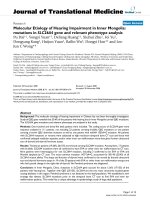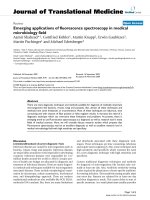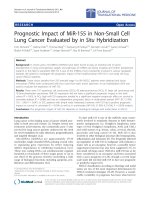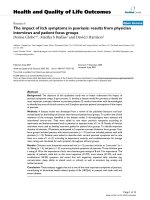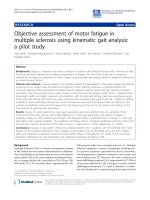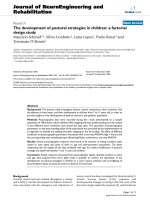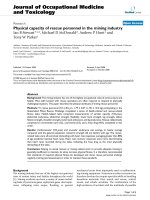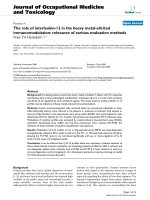báo cáo hóa học:" Kidney function of HIV-infected children in Lagos, Nigeria: using Filler’s serum cystatin C-based formula" docx
Bạn đang xem bản rút gọn của tài liệu. Xem và tải ngay bản đầy đủ của tài liệu tại đây (382 KB, 8 trang )
RESEARC H Open Access
Kidney function of HIV-infected children in Lagos,
Nigeria: using Filler’s serum cystatin C-based
formula
Christopher I Esezobor
1*
, Edna Iroha
1
, Olajumoke Oladipo
2
, Elizabeth Onifade
3
, Oyetunji O Soriyan
4
,
Adebola O Akinsulie
1
, Edamisan O Temiye
1
, Chinyere Ezeaka
1
Abstract
Background: Limited data is available on kidney function in HIV-infected children in sub-Saharan Africa. In
addition, malnutrition in these children further reduces the utility of diagnostic methods such as creatinine-based
estimates of glomerular filtration rate. We determined the serum cystatin C level and estimated glomerular filtration
rate of 60 antiretroviral-naïve, HIV-infected children and 60 apparently healthy age and sex matched children.
Methods: Serum cystatin C level was measured using enzyme-linked immunosorbent assay technique, while
glomerular filtration rate was estimated using Filler’s serum cystatin C formula. Student t test, Mann Whitney U test,
Pearson chi square and Fisher’s exact test were used, where appropriate, to test difference between groups.
Results: Compared to the controls, the HIV-infected group had significantly higher median (interquartile range)
serum cystatin C levels {0.77 (0.29) mg/l versus 0.66 (0.20) mg/l; p = 0.025} and a higher proportion of children
with serum cystatin C level >1 mg/l {10 (16.7%) versus one (1.7%); p = 0.004}. The HIV-infected children had a
mean (± SD) eGFR of 96.8 (± 36.1) ml/min/1.73 m
2
compared with 110.5 (± 27.8) ml/min/1.73 m
2
in the controls
(p = 0.021). After controlling for age, sex and body mass index, only the study group (HIV infected versus control)
remained a significant predicto r of serum cystatin C level (b = -0.216, p = 0.021). The proportion of HIV-infected
children with eGFR <60 ml/min/1.73 m
2
was eight (13.3%) versus none (0%) in the control group (p = 0.006).
However, the serum cystatin C level, eGFR and proportions of children with serum cystatin C level >1 mg/l and
eGFR <60 ml/min/1.73 m
2
were not significantly different between the HIV-infected children with advanced
disease and those with milder disease.
Conclusions: HIV-infected children in Nigeria have higher serum cystatin C level and lower eGFR compared to age
and sex matched controls.
Background
Although sub-Saharan Africa has the largest number of
children living with HIV, little is k nown about the pre-
valence of HIV-related kidney disease in these children
despite the recognition of HIV infection as a strong
initiation risk factor for kidn ey disease [1,2]. The dearth
of resources for care of children with kidney diseases
and the limited choice of antiretroviral drugs in Africa
underline a need to not only accurately assess
glomerular filtration rate (GFR) in these children, but to
do so early if their kidney function is to be preserved.
However, the well-known method of assessment of
kidney function using creatinine-based formulae is
fraught with several shortcomings in the general popu-
lation [3,4] and particularly in HIV-infected persons
[5]. Notably, creatinine clearance is significantly influ-
enced by tubular secretion [3,4] and the serum creati-
nine level is affected by non-renal factors, such a s diet,
race and lean mass. Also, the only method widely
available for clinical analysis of creatinine in Nigeria is
the modified kinetic Jaffe method with its accompany-
ing limitations [6].
* Correspondence:
1
Department of Paediatrics, College of Medicine, University of Lagos and
Lagos University Teaching Hospital, Idi-Araba, Lagos State, Nigeria
Esezobor et al. Journal of the International AIDS Society 2010, 13:17
/>© 2010 Esezobor et al; licensee BioMed Cent ral Ltd. This is an Open Access article distributed under the terms of the Creative
Commons Attribution License (http://cr eativecomm ons.org/licenses/by/2.0), which permits unre stricted use, distribution, and
reproduction in any medium, provided the original work is properly cited.
Moreover, malnutrition is common among children in
sub-Saharan Afri ca, especially in those living with HIV/
AIDS [7]. This further reduces the usefulness of serum
creatinine-based formulae i n the routine assessment of
kidney function and has implications for early detecti on
of impaired kidney function in these children [8].
Conversely, cystatin C, a 13 kilo dalton 120-amino
acid peptide produced at a fairly constant rate by the
house-keeping genes of all nucleated cells, has been
shown to be a better measure of glomerular filtration
[8-10]. Compared to creatinine, it is less affected by
non-glomerular factors, such as lean mass, diet and tub-
ular secretion [3,9,10]. Similarly, cystatin C-based
formulae for estimation of GFR closely mirror gold-
standard measures of GFR and reflect changes in GFR
earlier than creatinine-based formulae [8,11]. Of the sev-
eral cystatin C-based formulae for GFR, the one pro-
posed by Filler et al [11], developed from a study
involving children between the ages of o ne year and 18
years, has been shown to be of greater precision , lower
bias and highe r accuracy than the creatinine-based
formula of Schwartz and most other cystatin C-bas ed
formulae [12].
In the present study, we compared kidney function in
children with and without HIV infection attending the
outpatient clinics of the Lagos University Teaching Hos-
pital using the serum level of cystatin C, and estimated
GFR using Filler’ s cystatin C-based formula.
Methods
Study setting and population
The study was done between January and June 2008,
and was approved by the Hospital’s Research and Ethics
Committee. It was a cross-sectional observational study
of HIV-infected children attending the Paediatric Special
Clinic of the Lagos University Teaching Hospital. The
clinic, which provides comprehensive antiretroviral ther-
apy, is largely supported by the US President’sEmer-
gency Plan For AIDS Relief (PEPFAR).
The diagnosis of HIV infection was based on a docu-
mentary evidence of HIV infection using the enzyme-
linked immunosorbent assay (ELISA) test and confirmed
by western blot technique; for those who were diag-
nosed before the age of 18 months , diagnosis was based
on positive HIV DNA PCR tests on two separate sam-
ples. All consecutive HIV-infected antiretroviral-naïve
children, aged 18 months to 16 years and who met the
study criteria, were eligible. Excluded from the study
were childre n: with sickle cell disease, with cardiac dis-
ease o r previously confirmed kidney disease; those hos-
pitalized within the past two weeks; those with the
presence of any illness severe enough to require hospita-
lization; those with diarrhoea; and those who had used
systemic steroids within the past one week.
During the study time frame, 71 antiretroviral-naïve
HIV-infected children attended the Paediatric Special
Clinic, and 11 were excluded: six needed immediate
hospitalization for acute illnesses; three samples were
discarded because of haemolysis; and two had incom-
plete C D4+ cell count or per centage results. The
excluded children were not different in age and sex
distribut ion from t hos e enrolled. A one-to-one age and
sex matched pairing was done from a pool of HIV-
uninfected children. Age matching was done to the
nearest half year for those ≤ 5 years and to the nearest
year for those older than five years. Where more than
one control existed, a ballot was taken. The matching
was done prior to analysis of the sample for serum
cystatin C to avoid bias.
The controls were ambulatory, apparently healthy chil-
dren recruited while attending other clinics of the hospi-
tal: respiratory clinic (n = 17, those with bronchial
asthma, but not receiving systemic steroid or those
being followed up after hospitalization for bronchopneu-
monia); neurology clinic (n = 27, children with one or
more episodes of seizure referred to the clinic, but not
yet on anticonvulsants); surgical clinic (n = 11, children
prior to or after herniotomy, post appendicectomy); and
ear, nose and throat clinic (n = 5, those with speech or
hearing disorders).
No incentive to participate in the study was offered to
the caregivers. The inclusion and exclusion criteria were
the same for both groups of participants, except for the
absence of HIV infection in the control group.
Data collection
After informed consent, relevant clinical and demo-
graphic data were obtained by interviewing each care-
giver and physically examining each child. The clinical
notes and chest X-rays of each participating child with
HIV infection were also reviewed for a diagnosis of
tuberculosis. The data obtained were used in staging the
HIV disease, according to the revised World Health
Organization (WHO) paediatric clinical staging criteria
[13].
About 5 ml of blood was obtained from each partici-
pating child. Out of this, 2 ml was allowed to clot, and
the resulting serum after centrifugation was frozen at
-80°C until analysis. The remaining 3 ml of blood was
used for haemoglobin electrophoresis and CD4+ cell
count or percentage in the HIV-infected children and in
the controls for haemoglobin electrophoresis and detec-
tion of HIV antibodies (using Determine HIV rapid kit
™
manufactured by Abbot Japan Co Ltd for Inve rness
Medical Japan Co Ltd).
Inbatchesof30samples,the serum cystatin C was
measured by a sandwich enzyme-linked immunosorbent
assay for the quantitative measurement of human
Esezobor et al. Journal of the International AIDS Society 2010, 13:17
/>Page 2 of 8
cystatin C, using kits manufactured by BioVendor -
Laboratorni medicina a.s, Czech Republic. The intra-
assay co-efficient of variation (CV) for the quality
controls (QC) were as follows: low QC, 3.9%; high QC,
3.1%. The inter-assay CV were as follows: low QC, 6.8%
and high QC, 11.8%.
The estimated glomerular filtr ation r ate (eGFR)
(ml/min/1.73 m
2
) was der ived using a cystatin C-based
formula as proposed by Filler et al [11], i.e.
Log(GFR) 1.962 {1.123*log(1/cystatin C)}=+ ,
where 1/cystatin C is the reciprocal of the concentra-
tion of serum cystatin C in mg/l.
Advanced HIV d isease was defined clinically as WHO
Clinical Stage 3 disease or Clinical Stage 4 disease, or
immunologically as CD4+ cell count <350 cells/mm
3
(in
those ≥ 5 years old) o r CD4 percentage 20% (in those
younger than five years). Of the 35 children with
advanced HIV disease, 10 (28.6%) were classified based
on WHO clinical criteria only, 10 (28.6%) on immunolo-
gical criteria only, and 15 (4 2.9%) on both clinical and
immunological criteria.
Statistical analysis
ThedatawereanalyzedusingSPSSversion14.0(SPSS
for Windows Inc., Chicago, IL, USA) statistical software.
Anthropometric z scores were calculated using the
WHO AnthroPlus software developed using the WHO
Child Growth Standards and the WHO Reference 2007
[14]. Continuous data were summarized as mean (± SD)
and median (inter-quartile range) for parametric and
non-parametric data, respectively, while categ orical data
were represented as proportions. Pearson’sChisquare
or Fisher’s exact test was used to compare categorical
data, while Mann Whitney U test and Student’sttest
were used to analyse the non-parametric (serum cystatin
C) and parametric (eGFR) data, respectively.
A multiple linear regression, simultaneously account-
ing for weight, height, age, gender and study group
(HIV positive versus control) with log transformed
cystatin C as the dependent varia ble, was performed
(Model 1). A separate model (Model 2) was tested,
using age, sex, study group and body mass index (BMI)
as independent variables to avoid colinearity between
BMI and weight and height. Differences, correlations
(Spearman’s) and regression coefficient between vari-
ables were considered significant if the p value was less
than 0.05.
Results
Table 1 displays the results of the HIV-infected children
compared with the controls. Sixty children with HIV
infection and 60 apparently healthy, HIV-uninfected
children were studied. The median age was 5.5 (5.2)
years in the HIV-infected group and 5.3 (5.2) years in
the control. The HIV-infected children were leaner
(BMI z score -1.07 vs. -0.31; p = 0.04 8), shorter (HAZ
score - 1.00 vs. 0.05; p = 0.000) and weighed less (WAZ
score -1.30 vs. -0.15; p = 0.000) compared with children
in the control group.
The median serum cystatin C level was 0.77 (0.29)
mg/l in the HIV-infected group compared with 0.66
(0.20) mg/l in the control (p value = 0.025).
There was no statistically significant difference in the
cystatin C level of the controls rec ruited from the var-
ious clinics (result not shown). Similarly, 10 (16.7%)
children with HIV infection compared with one in
the control group (1.7%) had a serum cystatin C level
>1.0 mg/l (p value = 0.004). The mean eGFR was
96.8 (±36.1) ml/min/1.73 m
2
in the children with HIV
infection and was significantly lower than the e GFR of
110.5 (± 27.8) ml/min/1.73 m
2
in the control group
(p = 0.021). Conversely, eight (13.3%) of the children
with HIV infection, compared with none in the control
group, had an eGFR less than 60 ml/mi n/1.73 m
2
(p = 0.006).
Table 2 displays the characteristics of the children
with HIV infection. In children younger than five years
Table 1 Demographic and kidney-related characteristics
of study participants.
Characteristics HIV-infected
children
(n = 60)
Control
(n = 60)
p
value
Age (years)
Median (IQR) 5.5 (5.2) 5.3 (5.2) 0.990
a
<5 years, n (%) 28 (46.7) 26 (43.3)
Male gender, n% 35 (58.3) 35 (58.3) 1.00
b
Weight
Median (kg) 15.3 (8) 19.8 (11.9) 0.026
a
WAZ score -1.30 -0.15 0.000
a
Length/height
Median (cm) 107 (25) 115 (36) 0.181
a
HAZ score -1.00 0.05 0.000
a
BMIZ score -1.07 -0.31 0.048
a
Blood pressure, mean
(mmHG)
66.9 (10.9) 64.9 (7.7) 0.223
c
Serum cystatin C
median (mg/l) 0.77 (0.29) 0.66 (0.20) 0.025
a
>1.0 mg/l, no. (%) 10 (16.7) 1 (1.7) 0.004
b
Estimated GFR
mean (ml/min/1.73 m
2
) 96.8 (36.1) 110.5
(27.8)
0.021
c
<60 ml/min/1.73 m
2
, no.
(%)
8 (13.3) 0 (0) 0.006
b
WAZ: weight for age z score; HAZ: height for age z score; BMIZ: Body mass
index z score;
a
Mann-Whitney U test;
b
Pearson’s Chi square test;
c
Student t
test; IQR: interquartile range
Esezobor et al. Journal of the International AIDS Society 2010, 13:17
/>Page 3 of 8
of age, the median CD4 percentage was 12.6% in those
with advanced disease versus 25.1% in those with less
advanced disease. In children five years or older, the
median CD4 count was 343 cells/mm
3
in those with
advanced disease versus 568 cells/mm
3
in those with
less advanced disease (p = 0.002). There was no signifi-
cant difference in cystatin C level, eGFR and propor-
tions with serum cystatin C >1 mg/l and eGFR <60 ml/
min/1.73 m
2
between children with advanced disease
versus the l ess advanced disease, although most mea-
sures of kidney function were worse in the advanced
disease group.
The correlation of weight, length, BMI and age with
serum cystatin C was small and not significant in both
groups of children (Figure 1 &2). In mu ltiple linear
regression,thevariationincystatinCasexplainedby
both models was small and only reached significant pro-
portion i n Model 2 (model includ ing BMI), Table 3 and
Table 4. Only the study group (HIV infected versus con-
trol) remained a significant predictor of cystatin C after
controlling for other variables, including BMI.
Discussion
The study documented a high level of serum cystatin C
and significant reduction in eGFR in HIV-infected chil-
dren stable enough to attend the outpatient clinic of the
Lagos University Teaching Hospital. Though the mean
eGFR w as within the normal range, more HIV-infected
children than controls had eGFR less than 60 ml/min/
1.73 m
2
. Similarly, more HIV-infected children than
controls had a serum cystatin level greater than 1 mg/l,
a level associated with an increased risk of death from
cardiovascular and kidney diseases in elderly adults
[15,16].
The elevated serum cystatin C level in HIV-infec ted
children in this study is consistent with the reports of
the Fat Redistribution and Metabolic Change in HIV
infection (FRAM) study [5], the Nutrition for Healthy
Living Study [8] and Jaroszewicz et al [17]. The high
serum cystatin C level among the children with HIV
infection may imply a significant reduction in glomeru-
lar filtration because, unlike creatinine, glomerular filtra-
tion is the only significant means of the plasma
clearance of cystatin C [10 ,18]. HIV infection, by indu-
cing a glomerulopathy (as exemplified in HIV-associated
nephropathy), results in a reduction in the plasma clear-
ance of substance by glomerular filtration [2].
In agreement with results from the majority of studies
in this field [9,19-21], there was no s ignificant correla-
tion of serum cystatin C with age, sex, length, BMI and
weight. Only the study group remained a significant pre-
dictor of cystatin C. This is consistent with the report of
a recent study in children [21], which did not find any
association between cystatin C and body mass, although
studies involving adults have revealed varied re sults
[19,22,23].
Our finding of high prevalence of eGFR less than
60 ml/min/1.73 m
2
in the HIV-infected children is
consistent with a previous study [24], which documented
a proteinuria prevalence of 20.5% among this clinic
cohort of HIV-infected children. Similarly, a large body
of research [25-27] have documented high prevalence of
kidney dise ases in HIV-infected person s. Jones et al [8]
and Wools-Kaloustian and colleagues [27] reporte d pre-
valence of G FR less than 60 ml/min/1.73 m
2
between
11.5% and 15.2%, respectively; these findings are similar
to ours.
The high level of serum cystatin C and prevalence of
GFR less than 60 ml/min/1.73 m
2
in this coho rt of
HIV-infected children in Nigeria supports the associa-
tion between HIV infection and kidney disease [2,25],
and implies that HIV-related kidney dise ase may be as
common in African children as in children residing in
other regions of the world [24-26].
The significant reduction in GFR among HIV-infected
children stable enough to attend outpatient clinics prob-
ably indicates a chronic, rather than a rapidly evolving,
reduction in GFR. In sub-Saharan Africa, where the bur-
den of HIV infection is high and the dearth of resources
forkidneycareprofound,thehighprevalenceof
Table 2 Serum cystatin C and eGFR of children with different stages of HIV disease.
Variables Stage of HIV disease p value
Advanced
n=35
Not advanced
n=25
HIV-related variables:
For <5 years, CD4%, median (IQR) 12.6 (8.2) 25.1 (5.2) 0.000
a
For ≥ 5 years, CD4 count/mm
3
, median(IQR) 343 (488) 568 (507) 0.002
a
Serum cystatin C, median (mg/l) 0.79 (0.35) 0.76 (0.24) 0.196
a
Cystatin C >1.0 mg/l, no. (%) 8 (22.9) 2 (8) 0.119
b
eGFR, mean (ml/min/1.73 m
2
) 97.3 (4.2) 96.2 (23.6) 0.904
c
eGFR <60 ml/min/1.73 m
2
no. (%) 6 (17.1) 2 (8) 0.265
b
a
Mann Whitney U test;
b
Pearson’s Chi square test;
c
Student’sttest
Esezobor et al. Journal of the International AIDS Society 2010, 13:17
/>Page 4 of 8
glomerular dysfunction in HIV-infected children docu-
mented in this study warrants early detection of kidney
involvement in HIV infection and institution of mea-
sures that may halt progression to end-stage kidney
disease.
In donor-driven programmes (prevalent in the region)
where the c hoice of antiretroviral drugs is limited, t he
high proportion of HIV-infected children with GFR less
than 60 ml/min/1.73 m
2
, a GFR level that may require
adjustment of drug dosages, is of concern. It also
requires caution when rolling out antiretroviral drug
regimens, including indinavir, adefovir and tenofovir
that affect kidney function [5,28].
The lack of a significant difference between the GFR
in HIV-infected children with advanced stage of HIV
disease compared w ith those with less advanced stage
could be due to the criteria chosen for classification of
HIV disease into “advanced” and “not advanced” groups.
Also, the small sample size could have underpowered
the detection of any significant difference in eGFR and
serum cystatin C.
The inclusion of only antiretroviral-naïve, HIV-
infected children is a strength of this study because it
provided an opportunity to document the prevalence of
reduced GFR not confounded by the effects of highly
active antiretroviral therapy (HAART). To our
Figure 1 Correlation of serum cystatin C with age and weight in HIV-infected children (A & C) and in the controls (B & D).
Esezobor et al. Journal of the International AIDS Society 2010, 13:17
/>Page 5 of 8
Figure 2 Correlation of serum cystatin C with length and BMI in HIV-infected children (E & G) and in the controls (F & H).
Table 3 Multiple linear regression model simultaneously accounting for age, gender, length, weight and study group
(Model 1).
Independent variables Unstandardized coefficient Standardized coefficient p value
Constant -0.067 - 0.686
Age 0.016 0.341 0.173
Gender -0.009 -0.03 0.741
Length -0.001 -0.07 0.817
Weight -0.003 -0.205 0.301
Study group -0.055 -0.186 0.065
R
2
= 0.089, p = 0.057
Table 4 Multiple linear regression model simultaneously accounting for age, gender, study group and BMI (Model 2).
Independent variables Unstandardized coefficient Standardized coefficient p value
Constant -0.019 - 0.844
Age 0.006 0.129 0.155
Gender -0.010 -0.034 0.711
BMI -0.007 0.111 0.252
Study group -0.063 -0.216 0.0210
R
2
= 0.083 p.value = 0.039
Esezobor et al. Journal of the International AIDS Society 2010, 13:17
/>Page 6 of 8
knowledge, this is the first study to do so. Published
reports [5,8,17] of cystatin C or cystatin C-based eGFR
in HIV-infected persons included those on HAART
with regimens consisting of tenofovir and indinavir, and
the reported increase in serum cystatin C in these stu-
dies may have been confounded by the use of these
drugs [5,28]. We also analyze serum cystatin C in a sin-
gle laboratory, which helps to reduce systematic error.
Our limitations include estimation of GFR, rather than
actual measurement and unavailability of C-reactive pro-
tein, w hich has been shown to positively correlate with
cystatin C level [29]. However, a previous report [24] of
high prevalence of kidney disease in this clinic cohort of
HIV-infected children strengthens the validity of o ur
finding.
In conclusion, we have reported an elevated serum
cystatin C level unaffected by BMI and a high preva-
lence of GFR <60 ml/min/1.73 m
2
in antiretrovir al-
naïve, HIV-infected children attending the outpatient
clinic of the Lagos University Teaching Hospital.
Acknowledgements
Our sincere appreciation goes to the children and caregivers who
participated. We also acknowledge the contribution of Dr IMO Adetifa for
reviewing the study proforma. Also, we are grateful to the laboratory staff
for their professionalism.
Author details
1
Department of Paediatrics, College of Medicine, University of Lagos and
Lagos University Teaching Hospital, Idi-Araba, Lagos State, Nigeria.
2
Laboratory and Genomic Medicine, Department of Pathology and
Immunology, Washington University School of Medicine, St Louis, MO, USA.
3
Children’s Unit, Friarage Hospital, Northallerton, North Yorkshire, DL6 1JG,
UK.
4
Department of Clinical Pathology, College of Medicine, University of
Lagos and Lagos University Teaching Hospital, Idi-Araba, Lagos State, Nigeria.
Authors’ contributions
CIE and OO conceived the study and, with the other authors, participated in
the design, data collection, analysis and interpretation of the results. All
authors approved the final draft of the work. Personal funds were used for
this study.
Competing interests
The authors declare that they have no competing interests.
Received: 24 December 2009 Accepted: 18 May 2010
Published: 18 May 2010
References
1. Cohen SD, Kimmel PL: HIV-associated renal disease in Africa - a
desperate need for additional study. Nephrol Dial Transplant 2007,
22:2116-2119.
2. Kimmel PL, Barisoni L, Kopp JB: Pathogenesis and Treatment of HIV-
Associated Renal Diseases: Lessons from Clinical and Animal Studies,
Molecular Pathologic Correlations and Genetic Investigations. Ann Intern
Med 2003, 139:218-220.
3. Levey AS: Measurement of renal function in chronic renal disease. Kidney
Int 1990, 38:167-184.
4. Stevens LA, Coresh J, Greene T, Levey AS: Assessing kidney function:
measured and estimated glomerular filtration rate. N Engl J Med 2006,
354:2473-2483.
5. Odden MC, Scherzer R, Bacchetti P, Szczech LA, Sidney S, Grunfeld C,
Shlipak MG: Cystatin C level as a marker of kidney function in human
immunodeficiency virus infection. The FRAM Study. Arch Intern Med 2007,
167:2213-2219.
6. Afolabi MO, Abioye-Kuteyi EA, Arogundade FA, Bello IS: Prevalence of
chronic kidney disease in a Nigerian family practice population. SA Fam
Pract 2009, 51:132-137.
7. Arpadi SM: Growth failure in children with HIV infection. J Acquir Immune
Defic Syndr 2000, 25(suppl 1):37-42.
8. Jones CY, Jones CA, Wilson IB, Knox TA, Levey AS, Spiegelman D,
Gorbach SL, Van Lente F, Stevens LA: Cystatin C and creatinine in an HIV
cohort: the nutrition for healthy living study. Am J Kidney Dis 2008,
51:914-924.
9. Bokenkamp A, Domanetzki M, Zinck R, Schumann G, Byrd D, Brodehl J:
Cystatin C- A new marker of glomerular filtration rate in children
independent of age and height. Pediatrics 1998, 101:875-881.
10. Laterza OF, Price CP, Scott MG: Cystatin C: An improved estimator of
glomerular filtration rate? Clin Chem 2002, 48:699-707.
11. Filler G, Lepage N: Should the Schwartz formula for estimation of GFR be
replaced by cystatin C formula? Pediatr Nephrol 2003, 18:981-5.
12. White C, Akbari A, Hussain N, Dinh L, Filler G, Lepage N, Knoll GA:
Estimating glomerular filtration rate in kidney transplantation: a
comparison between serum creatinine and cystatin C-based methods. J
Am Soc Nephrol 2005, 16:3763-3770.
13. WHO: Interim WHO clinical staging of HIV/AIDS and HIV/AIDS case definitions
for surveillance. Geneva 2005.
14. WHO: WHO AnthroPlus for personal computers Manual: Software for assessing
growth of the world’s children and adolescents. Geneva 2009 [http://www.
who.int/growthref/tools/en/].
15. Shlipak MG, Sarnak MJ, Katz R, Fried LF, Seliger SL, Newman AB,
Siscovick DS, Stehman-Breen C: Cystatin C and the risk of death and
cardiovascular events among elderly persons. N Engl J Med 2005,
352(20):2049-2060.
16. Shlipak MG, Katz R, Sarnak MJ, Fried LF, Newman AB, Stehman-Breen C,
Seliger SL, Kestenbaum B, Psaty B, Tracy RP, Siscovick DS: Cystatin C and
prognosis for cardiovascular and kidney outcomes in elderly persons
without chronic kidney disease. Ann Intern Med 2006, 145(4):237-246.
17. Jaroszewicz J, Wiercinska-Drapalo A, Lapinski TW, Prokopowicz D,
Rogalska M, Parfieniuk A: Does HAART improve renal function? An
association between serum cystatin C concentration, HIV viral load and
HAART duration. Antivir Ther 2006, 11:641-645.
18. Grubb AO: Cystatin C - properties and use as diagnostic marker. Adv Clin
Chem 2000, 35:63-99.
19. Baxmann AC, Ahmed MS, Marques NC, Menon VB, Pereira AB, Kirsztajn GM,
Heilberg IP: Influence of muscle mass and physical activity on serum and
urinary creatinine and serum cystatin C. Clin J Am Soc Nephrol 2008,
3:348-354.
20. Finney H, Newman DJ, Thakkar H, Fell JME, Price CP: Reference ranges for
plasma cystatin C and creatinine measurements in premature infants,
neonates and older children. Arch Dis Child 2000, 82:71-75.
21. Sharma AP, Kathiravelu A, Nadarajah R, Yasin A, Filler G: Body mass does
not have a clinically relevant effect on cystatin C eGFR in children.
Nephrol Dial Transplant 2009, 24(2):470-474.
22. Muntner P, Winston J, Uribarri J, Mann D, Fox CS: Overweight, obesity, and
elevated serum cystatin C levels in adults in the United States. Am J Med
2008, 121:341-348.
23. Knight EL, Verhave JC, Spiegelman D, Hillege HL, De Zeeuw D, Curhan GC,
De Jong PE: Factors influencing serum cystatin C levels other than renal
function and the impact on renal function measurement. Kidney Int 2004,
65:1416-1421.
24. Esezobor CI, Iroha E, Onifade E, Akinsulie AO, Temiye EO, Ezeaka C:
Prevalence of proteinuria among HIV-infected children attending a
tertiary hospital in Lagos, Nigeria. J Trop Pediatr 2009.
25. Chaparro AI, Mitchell CD, Abitbol CL, Wilkinson JD, Baldarrago G, Lopez E,
Zilleruelo G: Proteinuria in children infected with the human
immunodeficiency virus. J Pediatr 2008, 152:844-849.
26. Eke FU, Anochie IC, Okpere AN, Ugboma H: Proteinuria in HIV positive
children- a pilot study [abstract]. Pediatr Nephrol 2007, 1456.
27. Wools-Kaloustian K, Gupta SK, Muloma E, Owino-Ong’or W, Sidle J,
Aubrey RW, Shen J, Kipruto K, Zwickl BE, Goldman M: Renal disease in an
antiretroviral-naïve HIV-infected outpatient population in western Kenya.
Nephrol Dial Transplant 2007, 22:2208-2212.
Esezobor et al. Journal of the International AIDS Society 2010, 13:17
/>Page 7 of 8
28. Gupta SK, Eustace JA, Wiston JA, Boydstun II, Ahuja TS, Rodriguez RA,
Tashima KT, Roland M, Francesschini N, Palella FJ, Lennox JL, Klotman PE,
Nachman SA, Hall SD, Szczech LA: Guidelines for the management of
chronic kidney disease in HIV-infected patients: recommendations of the
HIV Medicine Association of the Infectious Diseases Society of America.
Clin Infect Dis 2005, 40:1559-1585.
29. Stevens LA, Schmid CH, Greene T, Li L, Beck GJ, Joffe MM, Froissart M,
Kusek JW, Zhang Y, Coresh J, Levey AS: Factors other than glomerular
filtration rate affect serum cystatin C levels. Kidney Int 2009, 75:652-660.
doi:10.1186/1758-2652-13-17
Cite this article as: Esezobor et al .: Kidney function of HIV-infected
children in Lagos, Nigeria: using Filler’s serum cystatin C-based formula.
Journal of the International AIDS Society 2010 13:17.
Submit your next manuscript to BioMed Central
and take full advantage of:
• Convenient online submission
• Thorough peer review
• No space constraints or color figure charges
• Immediate publication on acceptance
• Inclusion in PubMed, CAS, Scopus and Google Scholar
• Research which is freely available for redistribution
Submit your manuscript at
www.biomedcentral.com/submit
Esezobor et al. Journal of the International AIDS Society 2010, 13:17
/>Page 8 of 8
